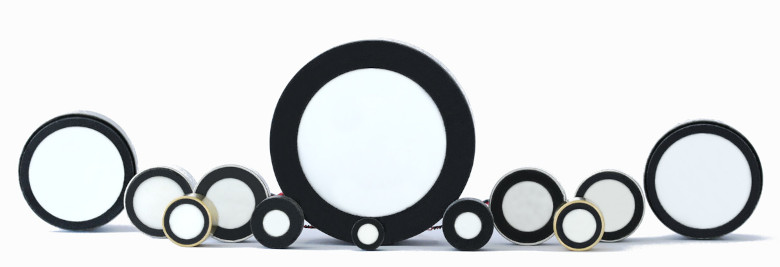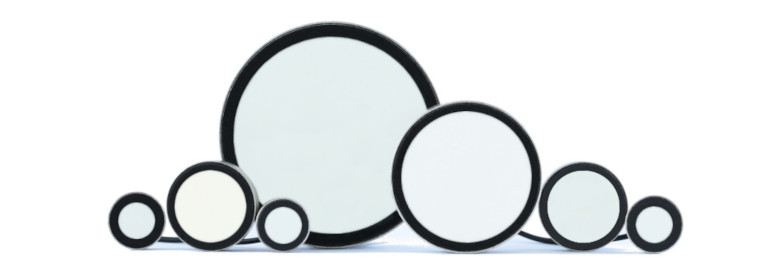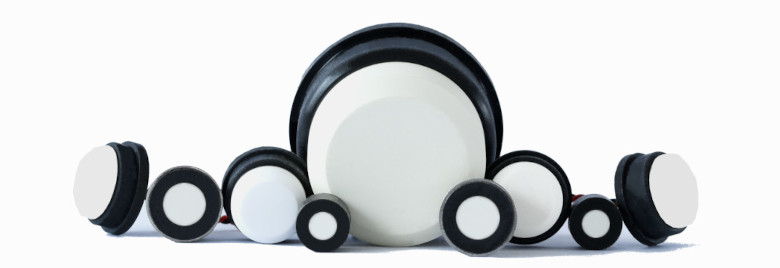Ultrasonic transducer assortment
The ultrasonic transducer is the heart of an ultrasonic sensor. It is the link between the sensor electronics and the measuring environment.
At SECO, we specialise in the development and manufacture of ultrasonic transducers for use in air and gases. In numerous sensory measurement tasks, our transducers are characterised by a high degree of flexibility and resistance. They function reliably even under adverse environmental conditions: dust, mist or mirrored surfaces have no negative effect on the measurement result.
Using ultrasonic waves, our transducers – like bats – determine the presence or distance of a reflecting object. They also gain information about the nature and state of motion of a reflector or transport medium. Depending on the size, our transducers operate with nominal frequencies in a range from 80 to 500 kHz and achieve ranges from 1 centimetre to 8 metres, depending on the measurement task.
Their functionality depends decisively on the quality of the piezo ceramic, the acoustic matching material and the damping matrix. We obtain our piezo ceramics – specially formulated for us – from our main supplier PI Ceramic (Link) in Germany. The acoustic matching material is manufactured in-house according to proven recipes. For the damping matrix, we use complex potting systems that we have optimised over decades with a great deal of experience.
Our product range is divided into three transducer types. Their mode of operation is based on the same technology, which we have further developed in each case with regard to special application advantages. We distinguish between multi-use transducers, focused transducers and pulsed transducers.

Multi-use transducers
Multi-use ultrasonic transducers are our flexible all-rounders.
They are characterised by a compact design with a comparatively small diameter. The transducer consists of a piezo ceramic and a matching disc. They have a long range, a high echo voltage and die relatively quickly. Another advantage is the cost-effective design, which reduces the number and quantities of materials required.
Furthermore, the multi-use transducers have a very large angle of beam due to their design. This makes the 300 kHz versions particularly suitable for anemometry applications. Selected variants can be optionally equipped with a focused sound lobe. This allows us to meet the requirements for an additionally amplified signal when the applications demand a smaller opening angle.

Focused transducers
Focused ultrasonic transducers are the perfect choice for long ranges.
Here, we supplement the structure of piezoceramics and matching material disc with a metal ring that increases the diameter of the radiating surface. This results in a well-focused sound lobe with a comparatively small opening angle that allows maximum sound distances. The additional mass of the metal ring also increases the transducer’s quality factor. This leads – with a slightly longer decay time – to a large amplitude of oscillation and high echo voltage.
The nominal frequencies of our focused transducers are in the range of 80 to 500 kHz. Compared to multi-use and pulsed transducers, directional transducers have the highest quality factor and the narrowest frequency bandwidth. Thus, the individual operating frequency lies within a narrow window around the nominal frequency.
We manufacture focused ultrasonic transducers in robust metal housings as standard.

Pulsed transducers
Pulsed transducers are the professionals for fast measurements at close range.
Compared to the other products in our range, the pulsed transducer has the highest damping and achieves the fastest settling and decay times. It can be excited with just a few oscillation cycles or a voltage pulse, making very high repetition rates possible. Therefore, this transducer type is particularly suitable for fast measurements with short distances to the target object or receiving transducer.
Due to its wide frequency bandwidth this transducer can be operated with different excitation principles: on discrete working frequencies, with sweep or pulse excitation.
Our pulsed transducers are perfect for applications such as flow measurement, double sheet control and web edge control.
The advantages of our transducer types
Multi-use transducer:
- large opening angle
- compact design
- cost-effective design
Focused transducer:
- long range
- minimum opening angle
- high echo voltage
Pulsed transducer:
- perfect for close range
- fast decay
- high repetition rates
- for compact measuring tasks/instrument dimensions
Key data of the three transducer types
| Nominal frequency [kHz] | 75…500 |
|
Frequency dispersion around nominal frequency [kHz] |
± 10…15 |
| Rel. echo voltage (order of magnitude) | 1 |
|
Burst cycles |
12…32 |
|
Echo decay cycles (at 1⁄2 UE) |
6…10 |
| Öffnungswinkel bei -3 dB [°] | 12…20 |
|
Opening angle at -3 dB [°] |
5000 |
|
Min. “blind zone” [mm] |
50 |
|
Nominal frequency [kHz] |
80…500 |
|
Frequency dispersion around nominal frequency [kHz] |
± 6…20 |
|
Rel. echo voltage (order of magnitude) |
10 |
|
Burst cycles |
32…80 |
|
Echo decay cycles (at 1⁄2 UE) |
10…20 |
| Opening angle at -3 dB [°] | 6…8 |
|
Max. Range (SECO test circuit) [mm] |
8000 |
|
Min. “blind zone” [mm] |
50 |
|
Nominal frequency [kHz] |
80…400 |
|
Frequency dispersion around nominal frequency [kHz] |
± 20 … 40 |
|
Rel. echo voltage (order of magnitude) |
0,2 |
|
Burst cycles |
Puls oder 1…12 |
|
Echo decay cycles (at 1⁄2 UE) |
2…4 |
|
Opening angle at -3 dB [°] |
9…12 |
|
Max. Range (SECO test circuit) [mm] |
500 |
| Min. “blind zone” [mm] | 20 |




